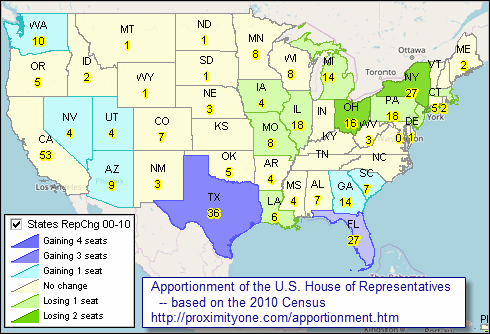

|
|
As of Census 2010 there were 308.7 million people in the United States, a 9.7 percent increase from the Census 2000 population of 281.4 million. The number of housing units increased from 115.9 million units in 2000 to 131.7 million units in 2010, an increase of 13.6 percent. The interactive ranking table provided below shows the Census 2000 and Census 2010 population and housing units for all states and the U.S. Use the ranking table to view/compare/contrast the largest/smallest states in 2000 or 2010 or states experiencing largest change. Click a column header to rank the table on a subject of interest; click a second time to sort in the other direction. Related sections ... • Statetrends Main Section • Demographic Projections to 2060 • 2020 Apportionment of the U.S. House of Representatives 2000-2010 Apportionment of the U.S. House of Representatives ... which states gained and lost seats  - view created with CV XE GIS. Click graphic for larger view with more detail. - use this GIS project on your computer. See details. U.S. & States Population & Housing Patterns: 2000-2010; Interactive Table Click column header to sort; click again to sort other direction. See related interactive tables Column Headers and Usage Notes - Population '00 -- Population, Census 2000 - Population '10 -- Population, Census 2010 - PChg0010 -- Population Change 2000-2010 - P%Chg0010 -- Population Percent Change 2000-2010 - Hsg Units '00 -- Housing Units, Census 2000 - Hsg Units '10 -- Housing Units, Census 2010 - HChg0010 -- Housing Units Change, 2000-2010 - H%Chg0010 -- Housing Units Percent Change, 2000-2010 Census 2010 State & Regional Profiles ... scroll section .. click link to view profile
U.S. & Regions/Divisions
United States Northeast Region Midwest Region South Region West Region New England Division Middle Atlantic Division East North Central Division West North Central Division South Atlantic Division East South Central Division West South Central Division Mountain Division Pacific Division States: Alabama Alaska Arizona Arkansas California Colorado Connecticut Delaware D.C. Florida Georgia Hawaii Idaho Illinois Indiana Iowa Kansas Kentucky Louisiana Maine Maryland Massachusetts Michigan Minnesota Mississippi Missouri Montana Nebraska Nevada New Hampshire New Jersey New Mexico New York North Carolina North Dakota Ohio Oklahoma Oregon Pennsylvania Rhode Island South Carolina South Dakota Tennessee Texas Utah Vermont Virginia Washington West Virginia Wisconsin Wyoming Puerto Rico ProximityOne User Group ... goto top Join the ProximityOne User Group to keep up-to-date with new developments relating to metros and component geography decision-making information resources. Receive updates and access to tools and resources available only to members. Use this form to join the User Group. Support Using these Resources Learn more about accessing and using demographic-economic data and related analytical tools. Join us in a Data Analytics Lab session. There is no fee for these one-hour Web sessions. Each informal session is focused on a specific topic. The open structure also provides for Q&A and discussion of application issues of interest to participants. Additional Information ProximityOne develops geodemographic-economic data and analytical tools and helps organizations knit together and use diverse data in a decision-making and analytical framework. We develop custom demographic/economic estimates and projections, develop geographic and geocoded address files, and assist with impact and geospatial analyses. Wide-ranging organizations use our tools (software, data, methodologies) to analyze their own data integrated with other data. Follow ProximityOne on Twitter at www.twitter.com/proximityone. Contact us (888-364-7656) with questions about data covered in this section or to discuss custom estimates, projections or analyses for your areas of interest. |
|
|